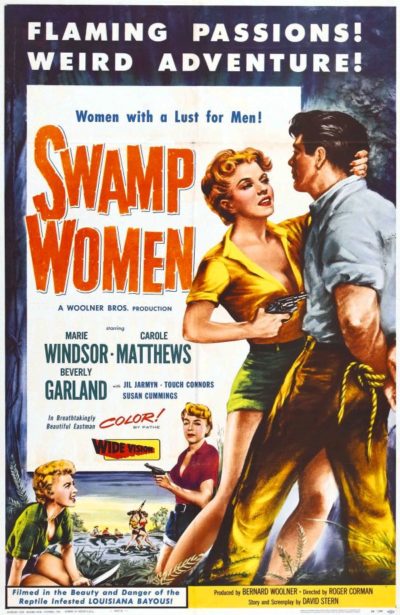★★★
“Marsh ado about nothing.”
 One of the earliest films directed by Roger Corman, it’d be a major stretch to call this a good film, yet I can’t deny I found it entertaining. It definitely has better female characters than most movies of the mid-fifties. Four women break out of jail and head into the swamps, in search of stolen diamonds which were previously hidden in the Louisiana swamps. Except, one of them is an undercover police officer, Lee Hampton (Mathews), who had been inserted into prison to join the gang and lead the escape, in the hope of recovering the loot. After the car breaks down, they hijack a boat owned by an oil prospector, Bob, and his girlfriend, taking them hostage as they head deeper into the bayou.
One of the earliest films directed by Roger Corman, it’d be a major stretch to call this a good film, yet I can’t deny I found it entertaining. It definitely has better female characters than most movies of the mid-fifties. Four women break out of jail and head into the swamps, in search of stolen diamonds which were previously hidden in the Louisiana swamps. Except, one of them is an undercover police officer, Lee Hampton (Mathews), who had been inserted into prison to join the gang and lead the escape, in the hope of recovering the loot. After the car breaks down, they hijack a boat owned by an oil prospector, Bob, and his girlfriend, taking them hostage as they head deeper into the bayou.
Things unfold more or less as you’d expect, though not exactly how Lee would have planned. There’s dissension in the ranks, fighting between the women for the attentions of Bob, encounters with native wildlife, and copious amounts of stock footage. The last is both of Mardi Gras in New Orleans and expensive elements like helicopters, helping pad the running-time, though it still comes in on the underside of seventy minutes. By all accounts, there was hardly a corner which Corman left uncut, such as the women doing their own stunts. Mike Connors, who played Bob, said, “The girls in that picture had it much worse than I did… They had to trudge through the mud, the swamps, pulling this rowboat, and I was sitting in the rowboat high and dry.”
Characterization beyond Lee is largely limited to the colour of the women’s hair – blonde, brunette, or redhead – though Josie (Marie Windsor, the star of Outlaw Women) is effective as the de facto leader of the group. It is nice there’s no attempt made to give them boyfriends or husbands. They make their own decisions, and follow through with them, entirely on their own terms. This brand of mid-fifties feminism results in more than one instance of them rolling around in the swamp, cat-fighting each other. Somehow, their hair, clothes and make-up miraculously seem to escape any kind of damage in these brawls, and return to pristine condition for the next scene.
On the way to the finale, Vera (Garland) tries to sneak off with both the jewels and Bob, paying the price for her treachery. The authorities manage to lose track of the group, and Josie grows increasingly suspicious of Lee’s resistance to violence. The leader eventually orders Lee to kill Bob; the shots fired in the ensuing fracas are enough, conveniently, to attract the search party, while Vera and Lee battle through the forest and – inevitably, into the water. It’s all entirely ridiculous, and the scope for parody makes it easy to understand why it was MST3K‘d. Yet even at this early stage, Corman clearly understood that the worst crime a B-movie can commit it is to be boring. For all its flaws, Swamp Women is never that.
Dir: Roger Corman
Star: Carole Mathews, Marie Windsor, Beverly Garland, Jill Jarmyn





 It’s the war between the Bolsheviks and the White Guard. A platoon of the former is left with no route of escape except across the desert to the Aral Sea. They begin the perilous trek, under Commander Yevsyukov (Kryuchkov), aided by the unit’s best sniper, Maria Filatovna (Izvitskaya). During the journey, they capture a White officer, Lieutenant Vadim Govorkha (Strizhenov, who looks kinda like Cary Elwes in The Princess Bride!) who is carrying information vital to his side. The Bolsheviks take him with them, as they head back to HQ, with Maria given the task of guarding him. But when she is separated from her comrades, and left with Vadim to fend for themselves after a storm, duty and loyalty to the cause of Communism becomes conflicted with other less revolutionary emotiona.
It’s the war between the Bolsheviks and the White Guard. A platoon of the former is left with no route of escape except across the desert to the Aral Sea. They begin the perilous trek, under Commander Yevsyukov (Kryuchkov), aided by the unit’s best sniper, Maria Filatovna (Izvitskaya). During the journey, they capture a White officer, Lieutenant Vadim Govorkha (Strizhenov, who looks kinda like Cary Elwes in The Princess Bride!) who is carrying information vital to his side. The Bolsheviks take him with them, as they head back to HQ, with Maria given the task of guarding him. But when she is separated from her comrades, and left with Vadim to fend for themselves after a storm, duty and loyalty to the cause of Communism becomes conflicted with other less revolutionary emotiona.